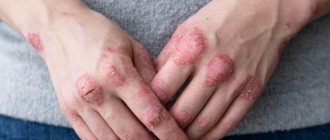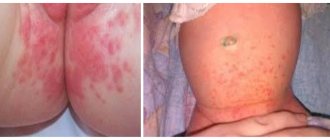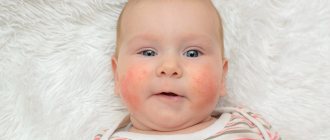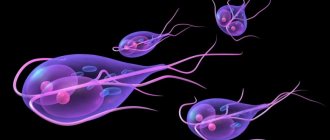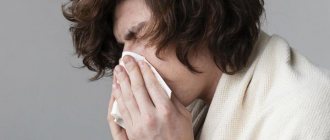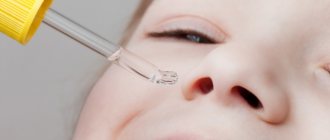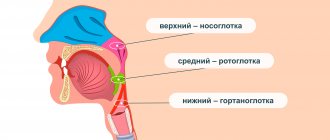Fenistil is a children's drop that has an antihistamine effect. This remedy is usually prescribed by doctors for allergic reactions in children. The popularity of the drug is due to the fact that it can be given almost from the first days of a baby’s life. The result of use can be observed within 15 minutes. It has a dispenser that allows you to measure the required dose. The drops have a pleasant taste and can be given undiluted.
Pharmacological properties of the drug Fenistil drops
Dimetindene maleate, a phenindene derivative, is a histamine antagonist at the level of H1 receptors. It has antikinin, weak anticholinergic and sedative effects. It has no antiemetic effect. Reduces increased capillary permeability associated with immediate allergic reactions. In combination with antagonists of histamine H2 receptors, it inhibits almost all types of histamine effects on the circulatory system. The bioavailability of dimethindene in the form of drops is about 70%. After oral administration, the maximum concentration in the blood plasma is reached within 2 hours. The half-life is about 6 hours. At concentrations from 0.09 to 2 μg/ml, the binding of dimethindene to plasma proteins is approximately 90%. Metabolic reactions include hydroxylation and methoxylation. Dimetindene and its metabolites are excreted in bile and urine. 5–10% of the administered dose of the drug is excreted unchanged in the urine.
Release form and composition
The active ingredient is dimethidene maleate. Excipients - liquid sorbitol, ethanol, sodium dihydrogen phosphate dihydrate. There are no alcohol, dyes or flavor enhancers. Does not have a specific smell.
Available in the following forms:
- emulsion. Sold in an 8 ml bottle, has a convenient applicator for application;
- gel. Sold in a 30 g tube, has a yellowish tint;
- drops for oral administration. Colorless liquid in a 20 ml bottle. A dropper is included to correctly determine the required dose.
Once in the body, the constituent substances are absorbed quickly and almost completely. It is excreted from the body along with urine or bile.
Indications for use of the drug Fenistil drops
Symptomatic treatment of seasonal (hay fever) and year-round allergic rhinitis; skin itching of various origins, with the exception of those associated with cholestasis; itching in diseases accompanied by skin rashes, chicken pox, insect bites; drug and food allergies; urticaria, as an adjuvant for eczema and other itchy dermatoses of allergic origin; prevention of allergic reactions during desensitizing therapy.
Causes
Most often, parents who do not adhere to the basic rules of caring for the child turn to doctors with complaints about heat rash in their baby: they bathe him with soap every day, wrap him up excessively without taking into account the real ambient temperature. Children with skin allergies, diabetes mellitus, rickets, seborrheic dermatitis or frequent diarrhea are also at risk. Chubby, overweight and bottle-fed babies are especially at risk of developing rashes.
Among other reasons for the development of prickly heat in children are:
- non-compliance with normal temperature conditions;
- too hot, tight clothes or shoes that do not allow air to pass through and do not create natural ventilation;
- excessive use of skin cosmetics that disrupt the acid balance and cause increased sensitivity (soaps, baby creams, oils, etc.);
- rare change of diapers or their poor quality, lack of care;
- viral diseases that are accompanied by fever.
Use of the drug Fenistil drops
Adults and children over 12 years of age and elderly patients. The daily dose is 3–6 mg in 3 divided doses: 20–40 drops 3 times a day. For patients prone to drowsiness, it is recommended to prescribe 40 drops before bedtime and 20 drops in the morning during breakfast. Children under 12 years of age. The drug is recommended after prior consultation with a doctor. The daily dose is 0.1 mg/kg body weight. The table shows daily doses for children aged 1 month to 12 years and for adults. Frequency of application - 3 times a day.
Age | Single dose/frequency of administration |
| 1 month—1 year | 3–10 drops/3 times a day |
| 1–3 years | 10–15 drops/3 times a day |
| 4–12 years | 15–20 drops/3 times a day |
| Adults | 20–40 drops/3 times a day |
20 drops = 1 ml = 1 mg dimethindene maleate.
Fenistil drops can be added to a bottle of warm baby food immediately before feeding. If the child is already being fed from a spoon, the drops can be given undiluted with a teaspoon. The drops have a pleasant taste.
Analogues and prices
Fenistil can be purchased at a pharmacy for 200-340 rubles (depending on the form of release). Gel with a volume of 30 g is sold for 200-270 rubles. Drops of 20 ml cost 280-340 rubles.
The drug has many analogues, which may differ in price. Budget options - Cetrin, Vibrocil. You can also find other inexpensive anti-allergy analogues, for example, Loratadine, Diazolin. Analogs for children should be purchased only after consultation with a doctor.
Fenistil should be stored at a temperature no higher than 25 degrees in a place where children do not have access and where sunlight does not penetrate. Once opened, the bottle can be stored for no longer than 2 years. Shelf life – 36 months. After the expiration date, the medicine cannot be used.
To purchase from a pharmacy, you do not need a doctor's prescription.
Special instructions for the use of the drug Fenistil drops
As with other antihistamines, caution should be exercised when prescribing Fenistil to patients with angle-closure glaucoma; in case of urination disorders, incl. with prostate hypertrophy, as well as in patients with chronic lung diseases. Influence on reaction speed when driving vehicles and working with machinery. When taking Fenistil drops, the reaction rate may slow down, so you should be careful when prescribing to patients who drive a car or work with mechanical means. During pregnancy and breastfeeding. During pregnancy, Fenistil drops can be prescribed only if the expected benefit to the mother outweighs the potential risk to the fetus. It is not recommended to take the drug during breastfeeding; if treatment with the drug is necessary, breastfeeding should be stopped. Children. In young children, antihistamines may cause agitation. Prescribe the drug in the form of drops to children under 1 year of age with caution: the sedative effect may be accompanied by episodes of sleep apnea.
Classification of the disease
There are four main types of miliaria, which differ in the nature of the rash, the duration of development and the severity of symptoms:
- Crystalline. It is accompanied by the development of a blistering rash, which most often appears on the head, behind the ears, and on the neck. Other localization of rashes is also possible. 2-3 days after the appearance, the blisters dry out and begin to peel off. Since irritation is not accompanied by inflammation or infection, the crystalline form is the simplest and most harmless.
- Red. A more complex type, in which sweat acts on the skin for a longer time and, accordingly, causes more severe irritation. A rash in the form of small inflamed tubercles provokes slight swelling and is accompanied by itching, burning, and discomfort. Lasts about two weeks.
- Miliaria alba, or vesiculopustulosis. With this type, blisters with a whitish or yellowish filling appear on the skin. When the bubble bursts, it leaves behind a light coating. The presence of color in the bubbly fluid indicates that the rash is accompanied by an infection, often staphylococcal.
- Deep. In most cases, prickly heat causes only superficial damage to the skin. With a deep form of pathology, the deep layers of the skin are affected. The disease is accompanied by blisters filled with light contents, which resolve or burst spontaneously.
Drug interactions Fenistil drops
When taken in combination, a mutual enhancement of the sedative effect of Fenistil drops and drugs that depress the central nervous system, such as tranquilizers, hypnotics and alcohol, is possible. With simultaneous consumption of alcohol, a more pronounced slowdown in the speed of psychomotor reactions is possible. When taken together with MAO inhibitors, it is possible to enhance the anticholinergic activity of antihistamines, as well as enhance their inhibitory effect on the central nervous system; therefore, their combined use is not recommended. Tricyclic antidepressants and anticholinergics may have additive anticholinergic effects when combined with antihistamines.
How to distinguish heat rash in a child from allergies and other diseases
When a rash appears on the skin, the most difficult thing for parents is to distinguish prickly heat from other diseases: allergies, chicken pox, measles, etc.
First, you should examine the location of the rash. In the first case, the rashes are located in hard-to-reach places: in the area under the diaper, in the folds of the skin, in the hairline. In this case, the rash almost never appears on open areas of the skin that are well ventilated. But if the rash appears on the face, open parts of the arms and legs, most likely it is an allergy.
A simple home test will also help make a differential diagnosis. You just need to undress the baby and leave him without clothes or a diaper for several hours. If the rash appears as a result of prickly heat, during this time it will decrease and become paler. If it is an allergy, no changes will occur to it.
Additional symptoms will help distinguish the disease from measles, chickenpox and other viral pathologies. With infectious diseases, the temperature always rises, intoxication appears, and the rash quickly spreads throughout the body. In turn, the main symptom of prickly heat is just a rash.
Overdose of the drug Fenistil drops, symptoms and treatment
In case of an overdose of Fenistil drops, like other antihistamines, the following symptoms may occur: central nervous system depression, drowsiness (mainly in adults), central nervous system stimulation and anticholinergic effects (especially in children), including agitation, ataxia, tachycardia, hallucinations, tonic or clonic convulsions, mydriasis, dry mouth, facial flushing, urinary retention and fever; arterial hypotension is possible. In the terminal stage of coma, depression of the respiratory and vasomotor centers may develop, leading to death. There is no specific antidote for an overdose of antihistamines. Standard measures should be taken: induce vomiting; if this fails, perform gastric lavage, take activated charcoal, saline laxative, and also take measures to maintain the function of the cardiovascular and respiratory systems. Vasoconstrictors can be used to treat arterial hypotension.
Symptoms
The main and most obvious symptom of the pathology is a rash. Most often, rashes appear on the head, chest, back, groin, armpits, and buttocks. The rash appears as scattered blisters with clear, white or yellow contents, or as small grains with an inflammatory outline.
During the day, the rash may intensify or decrease, and the severity of its manifestation depends on changes in temperature and care for the baby’s skin. In some cases, the child does not show concern, but sometimes may experience itching, pain and demonstrate discomfort with whims, unstable sleep, and lack of appetite.
In mild forms of the disease, other symptoms may not occur. But in more advanced cases, which are accompanied by complications and infection, clinical manifestations may be supplemented by:
- elevated temperature up to 38 degrees;
- the appearance of light plaque, ulcers, ulcers;
- the formation of weeping cracks with an unpleasant odor;
- general deterioration of condition.
When assessing symptoms, it is important to prevent the development of advanced forms of prickly heat and consult a doctor promptly, without waiting for complications to develop. Source: Skin care for a newborn. Solntseva O.A. Medical Council, 2014. p. 35-39.
What to feed a child with atopic dermatitis
In order not to provoke an exacerbation of dermatitis, to relieve itching and redness of the skin, you need to follow a diet. Foods that burden the immune system are excluded from the children's diet: citrus fruits, chocolate, eggs, honey, seafood. Red (strawberries, cherries, currants, apples) and exotic (mangoes, coconuts, pineapples) fruits are dangerous.
Split meals are recommended: small portions every 3-4 hours. It is better to boil, stew, bake, but not fry. Do not use spices, black pepper. The diet should be balanced and contain enough protein, vitamins, and microelements.
Avoid giving your child sugary carbonated drinks, chips, crackers and other snacks for as long as possible. If the infant is receiving breast milk, introduce new foods carefully. Add the product once a week to make sure it doesn't cause breakouts. After meals and between meals, offer your baby clean boiled water.
Diagnostics
You should not self-medicate or try to diagnose your child yourself. Before you begin to treat prickly heat in a child, when the first rash appears, you should contact a pediatric dermatologist or pediatrician. The specialist will conduct an examination and distinguish the pathology from other diseases that are accompanied by a skin rash. For an experienced pediatric specialist, this is not difficult even with an initial visual examination.
In some cases, additional examination is necessary for a comprehensive diagnosis. The doctor may prescribe scraping for pathogenic fungal infections, as well as bacterial culture for microflora.
